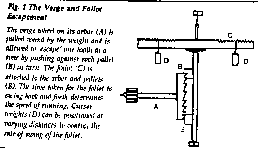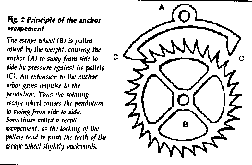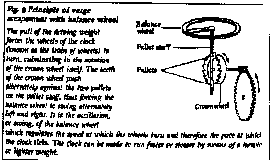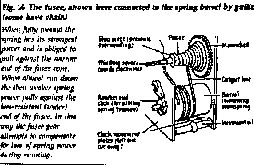|
|
|


This was typically four seconds. The foliot operated in horizontal plane
and the perpendicular rod had dogs which drove a crown wheel. This is called
a verge movement. The power came from a weight driven system and only the
hour was indicated. It would be accurate to within an hour or so a day.
The earliest examples were in religious institutions and told the members
when to go for prayers.
Rather than "read the time" they would listen for the strikes
on a bell. This explains why the majority of public timepieces in Europe
today are in churches and strike the hours.
Continuous improvements in design and manufacturing of clocks through the
14th century resulted in minutes as well as hours being displayed. By the
15th century elaborate clocks on cathedrals such as Wells Cathedral, Somerset,
England had added automaton features with male figures striking bells on
the hour.
Lantern clocks were the first small clocks to be designed for use in a house.
In place of the foliot they used a balance wheel on a verge movement. They
were weight driven and not particularly good time keepers.
The next major development was the addition of the pendulum. Leonardo da
Vinci knew about pendulums but did not apply his knowledge to clocks. Galileo
developed the pendulum technology and it was applied to the verge movement.
By the end of the 17th century the longcase or grandfather clock had been
developed and these kept time within a few minutes a day.
The verge movement was replaced by an anchor escapement (fig 2)

and the pendulum beat at once a second, the familiar tick tock we know
today. The movement consisted of two brass plates enclosing the necessary
wrought iron and brass gearing, steel spring or weight mechanism to drive
the clock. A silvered brass face and later a painted face would be pinned
onto the movement. The case itself ranged from the simplest oak case to
beautifully inlaid walnut veneers.
Clock making was now well established and the quality and volumes continued
to improve.
Portable clocks or watches now became more of a focus. The pendulum is impractical
in such movements so the verge movement with a balance wheel(Fig 3) was
the dominant design.

Only very poor spring material was available so the devices would only
run for a few hours at a time.
Fusee technology (Fig 4) was developed to compensate for the irregular tension
from an unwinding spring .

A tapered roller was driven by a chain from the spring drum and the roller
drove the movement, the taper offsetting the decreasing tension of the spring.
A spring was added to the balance and these timepieces would be accurate
to within 15 minutes a day.
The verge movement was replaced by several different mechanisms - cylinder,
duplex, from which the lever movement for watches became the predominant
design. The quality of manufacture of these movements is amazing. The brass
plates are mercury gilded with beautiful engraving, all steel parts were
blued and they were hand made to amazing tolerances given the level of technology.
They were truly masterpieces of engineering and artistry.
In 1720 the British government offered a prize of £20,000 for a clock
that would be accurate at sea to 3 seconds a day so that Longitude could
be measured to within plus or minus a degree by shooting the sun. As is
always the way, John Harrison, a carpenter not a clock or watch maker, eventually
won the prize. His first attempt was essentially a wooden movement with
some metal that weighed 90 lb. By 1770 he had produce a chronometer the
size of a large pocket watch that met the competition specifications.
In the early 19th century, clocks and watches were commonplace in the merchant
classes and the technology developed into two different directions. With
Europe becoming wealthier, there was a demand for sophisticated and elegant
timepieces for the wealthy. These included repeaters, watches which chimed
the hours and quarters, elaborate gold and enamel cases, and many other
elaborate jewellery type decorations. Watches had jewelled movements to
minimise wear and the traditional back plate was now split into sections
to facilitate mass production and make them thinner
The quality movements were provided by the Swiss and the French. By the
middle of the 19th century, Britain had lost its lead in the watch and clock
making business because of its craftsmen's reluctance to look at mass production.
Manufacturing techniques had become very precise and increasingly sophisticated.
By the end of the 19th century, companies like Waltham in the USA could
produce a reasonably accurate watch for a few dollars. In the first half
of the 20th century there were continued improvements in the manufacturing
of clocks, and technology based on electrical power was introduced for clocks.
Apart from not needing to be wound this offered few advantages.
The next significant change in technology came in the 1960s when the Swiss
Watch Industry Research Centre developed the electronic watch based on high
frequency resonance circuits. Since the Swiss watchmaking industry dominated
the mechanical watch manufacturing business they saw little reason to change.
The Research Centre sold the rights to the Japanese who decimated the traditional
SWISS watch industry within a few years. Today a watch can be purchased
for $20-30 that tells the time accurate to within a few seconds a year.
In fact, because the earth's rotation is slowing and because of the inadequacy
of the time/calendar system, adjustments have to be made to the accepted
time standard.
Along with the date, watches offer options such as a computer, pressure
(altitude) and temperature measurements and can even include a television.
Within a few years it will doubtless be possible to locate ones position
within 10ft anywhere on the earth via a satellite
based GPS receptor in one's watch.
Even John Harrison would have been amazed.